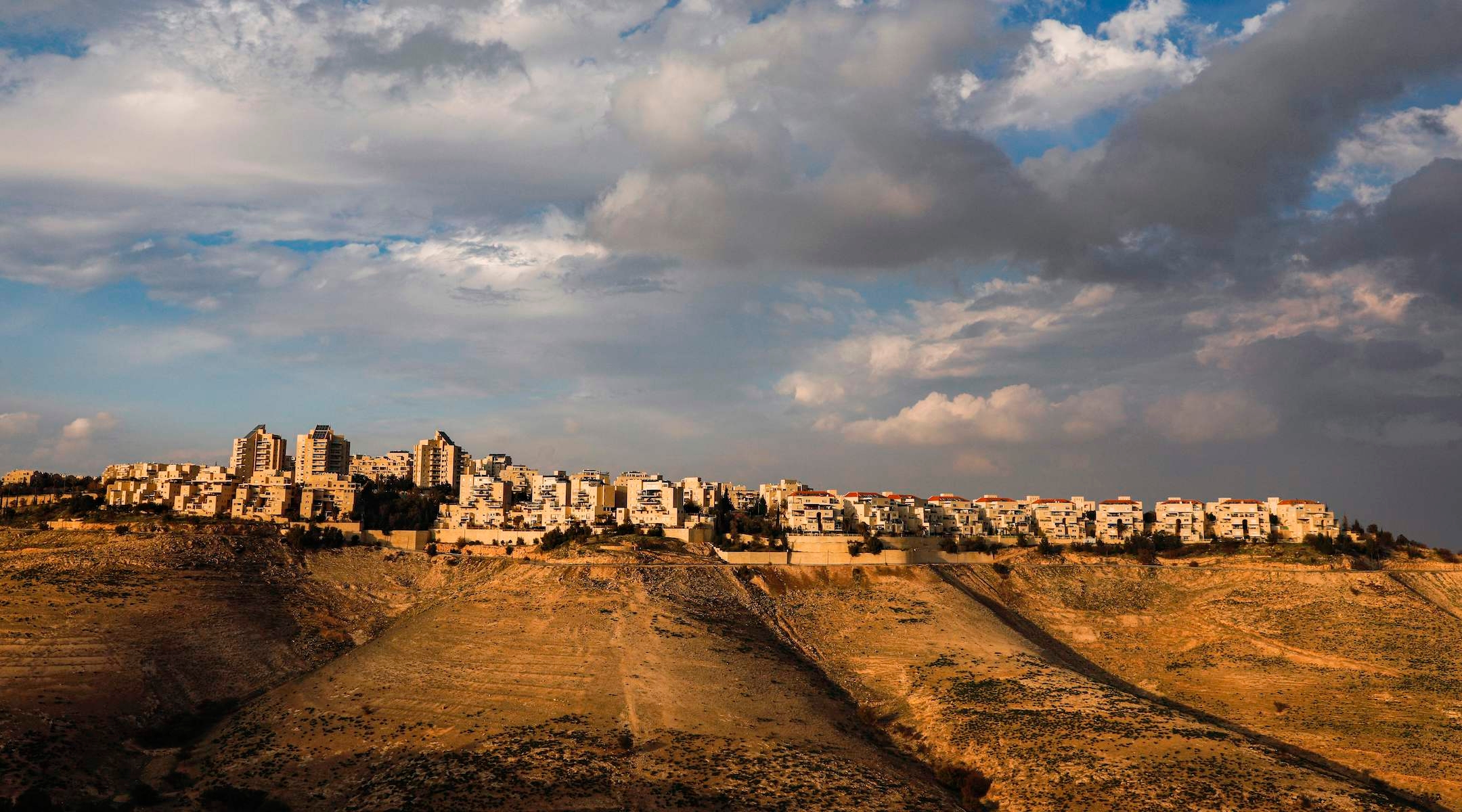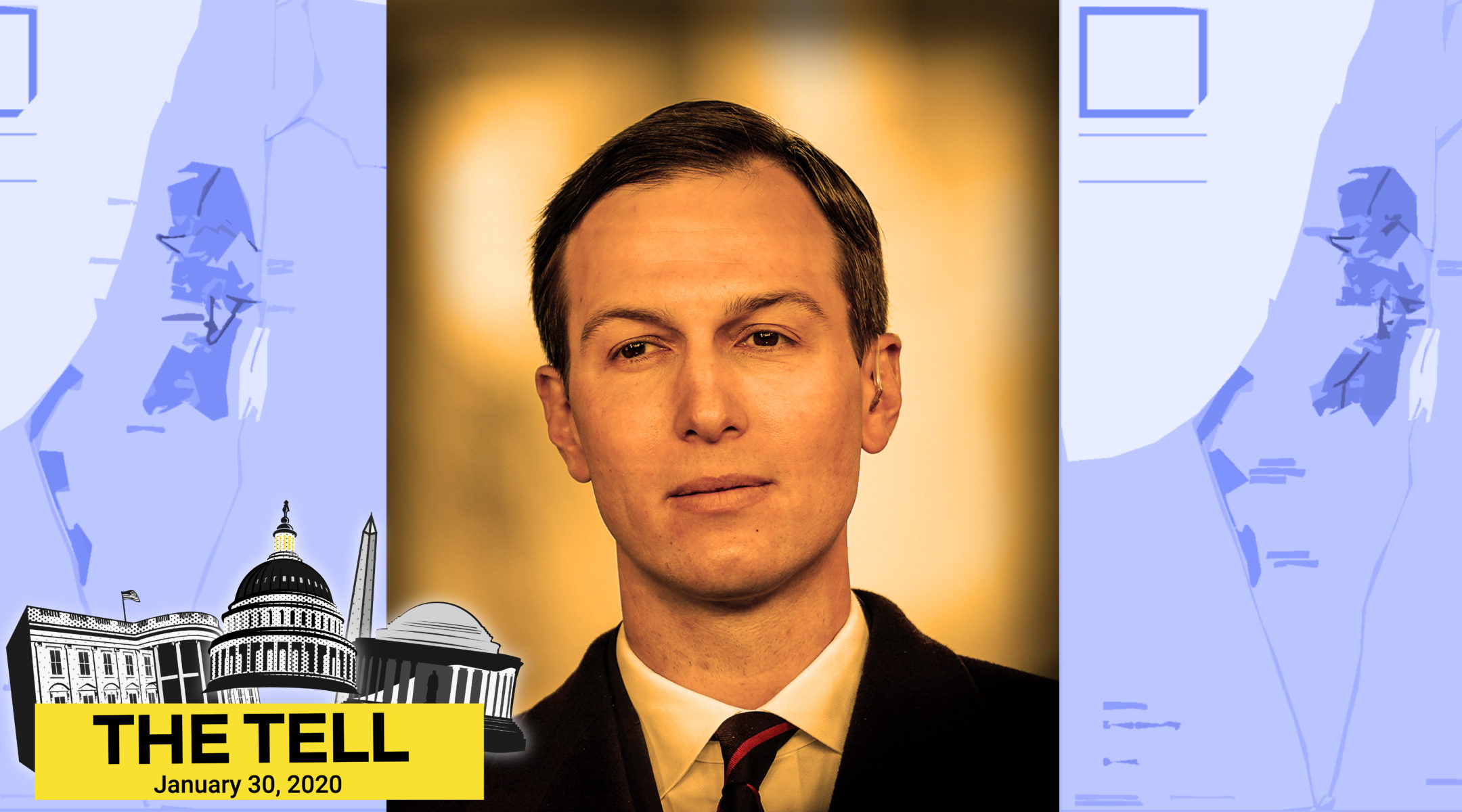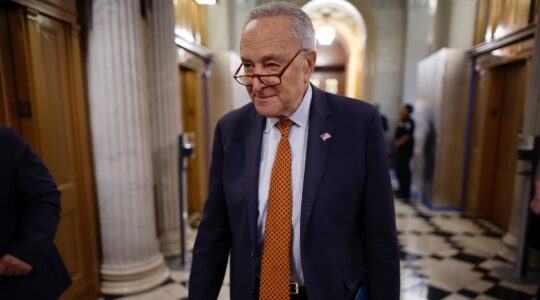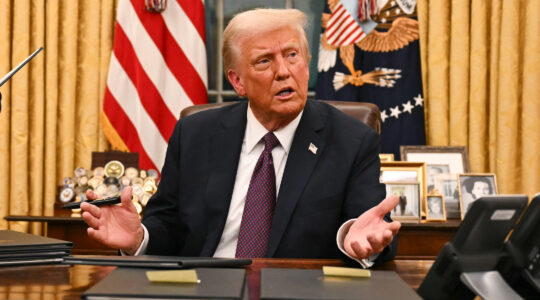WASHINGTON (JTA) — Call it the deal of the century, the ultimate deal, the vision for peace: President Donald Trump and his Middle East team unveiled their long-awaited peace plan on Tuesday. My colleague Gabe Friedman runs down the highlights (you can also read all 181 pages here and judge it for yourself).
The plan has its supporters, but it was also criticized and declared dead on arrival by numerous commentators. Here’s some of the important drama playing out around the release that you may have missed.
Kushner’s flustered
Jared Kushner, the presidential son-in-law and fixer of all that’s broke, was about as flustered as we’ve ever seen him after his plan was released. He really wants us to trust his wisdom: He told Sky News Arabia that he’s read 25 books on the conflict.
He also went on CNN Tuesday night to argue that the plan is extremely viable, if only the Palestinians would take it up.
“The Palestinian leadership have to ask themselves a question, do they want to have a state, do they want to have a better life,” Kushner said. “If they do, we have created a framework for them to have it and we’re going to treat them in a very respectful manner. If they don’t, then they’re going to screw up another opportunity like they’ve screwed up every opportunity that they’ve ever had in their existence.”
Kushner additionally cleaned up some of the mess surrounding Netanyahu’s controversial goal of imminent and unilateral annexation of Israel’s West Bank settlements, saying on Thursday that the U.S. will not support such a move until after Israel’s March elections.
“The Jordan Valley can mean a lot of different things,” the White House adviser said. “What we have now is almost like called more of a term sheet, and then we have to work over a couple months to turn that into a document that we can both feel good about.”
The part of the plan no one’s talking about but should be
Perhaps the most explosive part of the proposal has been given the least attention. The plan identifies a number of Arab towns along Israel’s border with the West Bank and suggests the towns and their residents can easily transition into a Palestinian state.
“The Triangle Communities consist of Kafr Qara, Ar’ara, Baha al-Gharbiyye, Umm al Fahm, Qalansawe, Tayibe, Kafr Qasim, Tira, Kafr Bara and Jaljulia. These communities, which largely self-identify as Palestinian, were originally designated to fall under Jordanian control during the negotiations of the Armistice Line of 1949, but ultimately were retained by Israel for military reasons that have since been mitigated. The Vision contemplates the possibility, subject to agreement of the parties that the borders of Israel will be redrawn such that the Triangle Communities become part of the State of Palestine,” the plan says.
How does this happen? Who is consulted? Do the residents, over 200,000, get a say? A few are Knesset members. If they don’t, is that consistent with international law?
Reporters asked Netanyahu at a briefing following the rollout exactly how this would come about. All he would say is that it would “come to a determination” without explaining what that means.
Do these communities even “largely self-identify as Palestinian”? The polls suggest it’s complicated. Moreover, despite signifiers of segregation — separate schools, virtually no intermarriage — there are many ways that these communities are integrated into Israel, through work and commercial relationships and friendships. Does that change with a stroke of the pen?
Settlement freeze on the hot seat
The plan also stipulates that Israel cannot “build any new settlement towns, expand existing settlements or advance plans to build in those areas” determined to be part of a future Palestinian state.”
The settlement movement in Israel has been driven — and still is to a degree — not by government but by rogues, pioneers, cowboys, call them what you like: Folks who settle first and ask permission later. Why would that stop just because Netanyahu says it should?
In Netanyahu’s briefing, I asked him how Israel would enforce the settlement freeze. He dismissed the question, saying “Israel has a government and an army.”
Yes it does. But it also had a government and an army in the late 1960s and the 1970s when those first unsanctioned settlements were going up. Now those very settlements could be on the verge of being annexed to Israel.
Status Qua?
There were titters in the room during the announcement news conference when Trump called the third holiest mosque in Islam Al-Aqua (it’s Al-Aqsa). But there were more serious signs that the folks who put the deal together weren’t quite aware of the status of Haram al Sharif, as the entire enclave is known, also known as the Temple Mount — the holiest site in Judaism.
“Jerusalem’s holy sites should remain open and available for peaceful worshippers and tourists of all faiths,” the plan’s text reads. “People of every faith should be permitted to pray on the Temple Mount/Haram al-Sharif, in a manner that is fully respectful to their religion, taking into account the times of each religion’s prayers and holidays, as well as other religious factors.”
The point about “people of every faith” praying on the Temple Mount is extremely sensitive. Although activists want this to change, Jews currently are not allowed to pray on the Temple Mount by the site’s Jordanian authority. The issue has periodically led to violent attacks on Jewish worshippers and pushback by Israeli security. Changing the status quo by fiat drafted in Washington is sure to cause a dilemma.
In Other News
Democrats don’t like the plan, but does AIPAC?
Democrats to a lawmaker and to a candidate have slammed the Kushner plan for not consulting Palestinians and for greenlighting Israeli unilateralism. Many of these lawmakers — Josh Gottheimer of New Jersey stands out — are to the party’s right on matters related to Israel.
“A lasting agreement about critical issues like borders will only come from direct negotiations with both parties,” Gottheimer said in a statement. “Any unilateral actions in the meantime, by either side, will only make it harder to achieve peace.”
That echoed the statement posted ahead of the deal’s release by Senate Minority Leader Chuck Schumer of New York (like Gottheimer, Jewish), who said: “Unilateral action taken by either side in response to the release of the Trump administration’s plan will diminish the prospects of a future peace.”
You know who tweeted out Schumer’s statement? The American Israel Public Affairs Committee, as well as naysaying by other AIPAC-aligned Democrats like Sen. Robert Menendez of New Jersey, and Eliot Engel and Nita Lowey of New York. AIPAC’s statement was in itself as hedged as hedged bets get.
“We appreciate the efforts of President Trump and his administration to work in consultation with the leaders of the two major Israeli political parties to set forth ideas to resolve the conflict in a way that recognizes our ally’s critical security needs.” (“Appreciate the efforts” — Ouch! A phrase that brings back bad memories of high school gym class.)
But AIPAC also tweeted lots of folks who praised the plan, including the Conference of Presidents of Major American Jewish Organizations.
Bernie’s heart and Israel
The kishkes question has for years haunted considerations of presidential candidates and Israel. Now we have the heart question. As in the real thing, the one with ventricles.
Democratic Majority for Israel, a political action committee advocating for a more AIPAC-aligned outlook among Democrats, released an ad in Iowa ahead of next week’s caucus in which voters wonder whether Bernie Sanders’ social democracy will fly in the election, and whether his ticker is up to it.
“I do have some concerns about Bernie Sanders’ health considering the fact that he did have a heart attack,” one voter says.
Not mentioned in the Democratic Majority for Israel ad? Israel.
Sanders, NBC reports, has already pushed back.
Keepin’ it real about anti-Semitism
Rep. Carolyn Maloney, D-N.Y., the chairwoman of the House Oversight Committee, convened a hearing on Wednesday — two days after International Holocaust Remembrance Day — to consider the rise in anti-Semitism.
Rep. Jim Jordan, R-Ohio, set the template for virtually every other Republican on the committee by solemnly denouncing the phenomenon and then pivoting to how robustly President Trump has defended Israel.
“We should all be proud of this close friendship with Israel and the Israeli people,” he said.
It was a preemptive defense against Democrats who tied the rise in white nationalism to Trump — and to be fair, a few did, including Jamie Raskin of Maryland and Tom Malinoski of New Jersey. But the testimony, by experts on anti-Semitism including a Holocaust survivor, Nat Shaffir, was more about confronting the phenomenon on the left and the right. The Republicans’ efforts to make it about Trump support was jarring.
Even Dore Gold, the witness invited by the Republican minority and the president of the Jerusalem Center for Public Affairs, grew impatient with being asked to praise Trump.
“I do not want to get drawn into your American domestic ping pong,” Gold told one Republican, Bob Gibbs of Ohio.
Taking Republicans to task was Democrat Debbie Wasserman Schultz of Florida.
“It would be hard to feel more strongly that Israel remain a Jewish democratic state and also that this hearing has nothing to do with our support and belief that Israel should remain so,” she said.
The Jewish campaigns
Sanders released a 4-minute video launching his Jewish campaign that uses the word “kishkes.” Mike Bloomberg did him one better and launched his Jewish campaign in South Florida at a Jewish community center, citing the week’s parsha to boot.
Worth A Look

A view of the Maale Adumim settlement in the West Bank, Jan. 28, 2020. (Menahem Kahana/AFP via Getty Images)
Douglas Feith, a senior fellow at the Hudson Institute and an undersecretary of defense under President George W. Bush, argues in The Wall Street Journal that the Kushner plan may work by “encouraging constructive resignation on the part of the Palestinians.”
A Tweet So Sweet
What do you call this latest emoji? The “rak rega” emoji? Emojipedia calls it “pinched fingers.” Whatever you term it, Quentin Somerville, the Middle East correspondent for the BBC, sees the codification of the regional signifier for “hold on to your horses” as welcome good news.
Stay In Touch
Share your thoughts on The Tell, or suggest a topic for us. Connect with Ron Kampeas on Twitter at @kampeas or email him at thetell@jta.org.
The Tell is a weekly roundup of the latest Jewish political news from Ron Kampeas, the Jewish Telegraphic Agency’s Washington Bureau Chief. Sign up here to receive The Tell in your inbox on Thursday evenings.
JTA has documented Jewish history in real-time for over a century. Keep our journalism strong by joining us in supporting independent, award-winning reporting.






